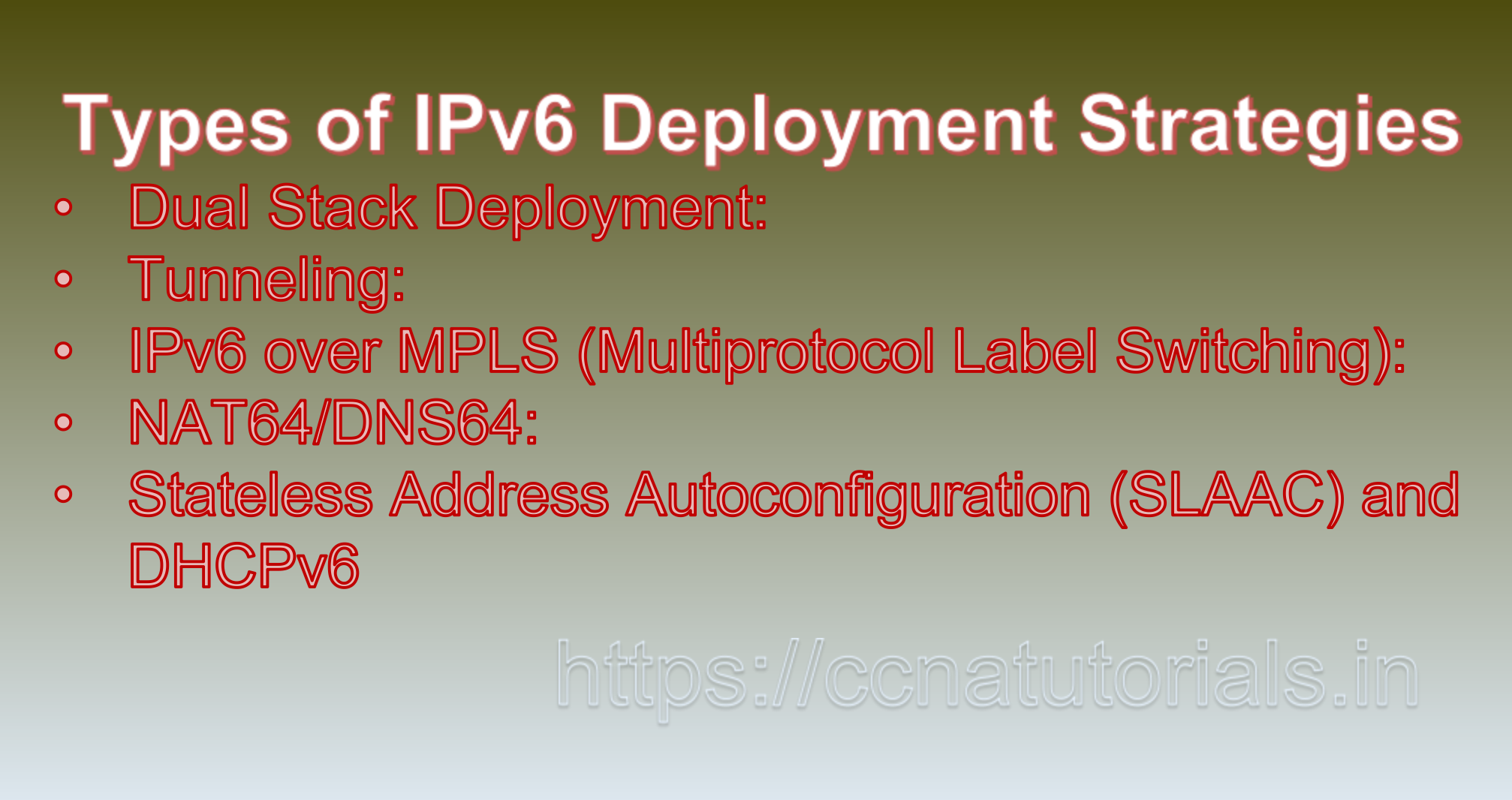Contents of this article
In this article, I describe IPv6 Deployment Strategies: Transitioning to the Future of Networking IPv6 deployment strategies are approaches that organizations adopt to transition from the traditional IPv4 protocol to the modern IPv6 protocol. As IPv4 address exhaustion becomes a pressing concern, IPv6 offers a solution with its expanded address space and enhanced features. However, transitioning to IPv6 requires careful planning and execution to ensure a smooth migration while maintaining network functionality and connectivity. This article provides an overview of IPv6 deployment strategies along with real-world examples to illustrate their implementation.
1. Dual Stack Deployment:
Overview: Dual Stack deployment involves running both IPv4 and IPv6 protocols concurrently on network devices. This strategy allows devices to communicate using either protocol, ensuring compatibility with both IPv4 and IPv6 networks.
Advantages:
– Seamless coexistence of IPv4 and IPv6 networks.
– No immediate need for translation or complex configuration.
– Gradual migration, enabling incremental adoption of IPv6.
Example Scenario: A company implements dual stack deployment by configuring its routers, switches, and servers to support both IPv4 and IPv6. As devices and services transition to IPv6, they can seamlessly communicate with both IPv4 and IPv6 clients.
2. Tunneling:
Overview: Tunneling involves encapsulating IPv6 packets within IPv4 packets, allowing them to traverse IPv4-only networks. This enables connectivity between IPv6 islands over an IPv4 network infrastructure.
Advantages:
– Immediate connectivity between remote IPv6 networks.
– Enables gradual IPv6 adoption without an overhaul of the existing network.
Example Scenario: An organization with an existing IPv4 network wants to establish connectivity with a remote IPv6 network. They set up an IPv6-over-IPv4 tunnel, encapsulating IPv6 packets within IPv4 packets. This enables communication between the two networks even though the intervening network only supports IPv4.
3. IPv6 over MPLS (Multiprotocol Label Switching):
Overview: IPv6 over MPLS involves deploying MPLS networks that carry both IPv4 and IPv6 traffic. This approach leverages the benefits of MPLS, such as traffic engineering and Quality of Service (QoS), for IPv6 communication.
Advantages:
– Utilizes MPLS benefits for IPv6 networks.
– Enables seamless transition with MPLS support in the core network.
Example Scenario: An Internet Service Provider (ISP) offers IPv6 connectivity to its customers using an MPLS network. This allows the ISP to provide high-performance IPv6 services while leveraging MPLS’s traffic optimization capabilities.
4. NAT64/DNS64:
Overview: NAT64/DNS64 is a strategy that enables communication between IPv6-only devices and IPv4-only devices. It involves using Network Address Translation (NAT) to map IPv6 addresses to IPv4 addresses and using DNS64 to synthesize AAAA records for IPv6 connectivity.
Advantages:
– Enables IPv6-only devices to communicate with IPv4-only devices.
– Facilitates communication in scenarios where one side is IPv6 and the other is IPv4.
Example Scenario: An organization has migrated its internal network to IPv6 but still needs to communicate with external IPv4-only servers. They implement NAT64/DNS64, allowing their IPv6 devices to communicate with external IPv4-only servers using synthesized IPv6 addresses.
5. Stateless Address Autoconfiguration (SLAAC) and DHCPv6:
Overview: SLAAC is a feature that automatically configures IPv6 addresses for devices using the network’s prefix. DHCPv6 (Dynamic Host Configuration Protocol for IPv6) provides additional configuration options for devices in an IPv6 network.
Advantages:
– Simplifies address configuration for devices.
– Enables efficient distribution of network configuration information.
Example Scenario: A home network implements SLAAC for devices to automatically configure IPv6 addresses. Additionally, they use DHCPv6 to provide specific configuration details like DNS server addresses and domain search lists.
6. IPv6-Only Networks:
Overview: In this strategy, an organization deploys IPv6-only networks, promoting a future where IPv6 becomes the primary protocol. This approach avoids the complexities of maintaining dual-stack environments.
Advantages:
– Forces a faster transition to IPv6.
– Simplifies network management by focusing solely on IPv6.
Example Scenario: A forward-looking organization decides to create a new branch office with an IPv6-only network infrastructure. All devices and services within this network use IPv6 exclusively, avoiding the complications of maintaining dual-stack environments.
In short IPv6 Deployment Strategies:
IPv6 deployment strategies are crucial for the successful transition from IPv4 to IPv6, ensuring seamless connectivity, compatibility, and improved network functionality. Organizations can choose from various strategies based on their existing network infrastructure, business needs, and technological readiness. Whether adopting dual stack, tunneling, MPLS integration, NAT64/DNS64, SLAAC/DHCPv6, or implementing IPv6-only networks, careful planning and execution are vital to ensuring a smooth transition while maintaining network reliability and performance. As IPv4 addresses become scarcer, the adoption of IPv6 deployment strategies becomes increasingly essential for organizations aiming to thrive in the evolving digital landscape.

IPv6 Deployment Strategies provide Transitioning to the Next Generation Internet Protocol.
IPv6 deployment strategies are essential for organizations looking to transition from the current IPv4 protocol to the newer IPv6 protocol. With the depletion of IPv4 addresses and the expansion of Internet-connected devices, adopting IPv6 is becoming increasingly important. IPv6 offers a larger address space, improved security features, and better support for emerging technologies. This article presents an overview of IPv6 deployment strategies, along with examples that illustrate the various approaches organizations can take.
IPv6 Deployment Strategies:
1. Dual Stack Deployment:
– Description: In a dual stack deployment, both IPv4 and IPv6 protocols are enabled and coexist within the network infrastructure. Devices, routers, and applications support both protocols, allowing for a gradual transition.
– Advantages: Provides a smooth transition path as IPv4 and IPv6 can operate side by side. Ensures compatibility with existing IPv4 infrastructure.
– Example: An organization adopts dual stack deployment by configuring its routers, servers, and clients to support both IPv4 and IPv6. This allows devices to communicate using either protocol, based on the availability of IPv6 connectivity.
2. Tunneling:
– Description: Tunneling involves encapsulating IPv6 packets within IPv4 packets to traverse an IPv4-only network. Various tunneling mechanisms, such as 6to4, Teredo, and ISATAP, facilitate the transit of IPv6 traffic over IPv4 networks.
– Advantages: Enables organizations to connect isolated IPv6 islands across an IPv4 network. Suitable for transitioning in environments where IPv6 deployment is limited.
– Example: An organization operates an IPv6-only branch office that needs to communicate with its IPv4-based headquarters. By setting up an IPv6-over-IPv4 tunnel, the organization ensures connectivity between the two locations.
3. NAT64/DNS64 Translation:
– Description: NAT64 translates IPv6 addresses into IPv4 addresses and vice versa. DNS64 complements NAT64 by creating synthesized AAAA records for IPv4-only domains, allowing IPv6 clients to communicate with IPv4 servers.
– Advantages: Facilitates communication between IPv6-only and IPv4-only devices without requiring dual stack support on both ends.
– Example: A user with an IPv6-only device wants to access an IPv4-only website. The NAT64 gateway translates the IPv6 request to an IPv4 request, and the DNS64 server creates a synthetic IPv6 address. This allows the user’s IPv6 device to access the IPv4-only content.
4. Application-Level Gateway (ALG):
– Description: ALGs act as intermediaries, translating protocols between IPv4 and IPv6. This approach is useful for scenarios where specific applications or services need to be transitioned while the underlying network remains unchanged.
– Advantages: Allows gradual migration of specific applications to IPv6 while keeping the rest of the network running on IPv4.
– Example: An organization has a legacy customer relationship management (CRM) application that only supports IPv4. By deploying an IPv6-to-IPv4 ALG, the organization enables IPv6 users to access the CRM application seamlessly.
5. IPv6-Only Deployment with NAT64/DNS64:
– Description: In an IPv6-only deployment, NAT64 and DNS64 translation mechanisms are used to enable communication with IPv4-only resources. This strategy encourages the adoption of native IPv6 within the organization’s infrastructure.
– Advantages: Promotes a pure IPv6 environment while ensuring access to IPv4 resources. Simplifies network management by eliminating dual stack complexity.
– Example: An organization sets up its network infrastructure with native IPv6 support, deploying NAT64 and DNS64 to enable communication with IPv4-only services on the Internet.
Conclusion for IPv6 Deployment Strategies:
IPv6 deployment strategies are vital for organizations seeking to embrace the capabilities of the next generation Internet Protocol. The examples provided illustrate various approaches, such as dual stack deployment, tunneling, NAT64/DNS64 translation, application-level gateways, and IPv6-only deployment. Each strategy comes with its own advantages and considerations, catering to the organization’s specific needs and goals. As IPv4 address exhaustion accelerates and the demand for Internet-connected devices grows, selecting an appropriate IPv6 deployment strategy is crucial for ensuring seamless communication, future-proofing network infrastructure, and supporting the ongoing expansion of the digital landscape. You may contact us for any query related to this article.






